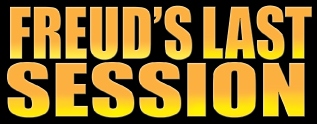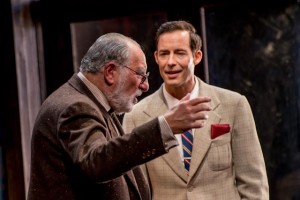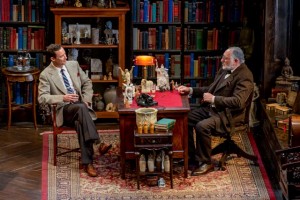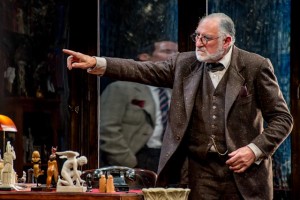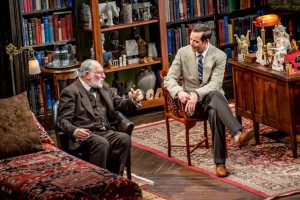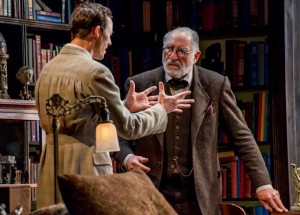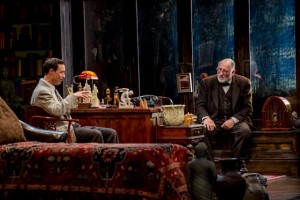TALKING HEADS
Mark St. Germain’s commercially successful two-hander Freud’s Last Session, suggested by The Question of God by Dr. Armand M. Nicoli, Jr., is about a speculative meeting between the titular founder of Psychoanalysis and Christian author/Oxford professor C. S. Lewis. Having cut its teeth at The Barrington Stage Company followed by a long run both Off-Broadway and in Chicago, Freud’s Last Session has landed in Santa Monica at The Broad Stage with the star-studded cast of Judd Hirsch and Tom Cavanagh.
Set in Freud’s London study on the eve of World War Two, the 80-minute one-act finds Freud at the end of his illustrious career and Lewis at the very beginning of his. St. Germain’s play, unfortunately, is more philosophical polemic, an argument for and against theism, than anything closely resembling an authentic theatrical event. Unfortunately, this slight character study with no discernable dramatic incident hardly merits a month-long run on one of the Southland’s premiere stages. The paper-thin plot is lacking in any true suspense or mystery, and neither character experiences anything close to a transformation. St. Germain teases the audiences with implications that both men may have suffered father issues, but the psychobabble proves a red herring as St. Germain always veers the piece back to his agenda of religious discourse, albeit superficial. The audience is left with an evening that is one part Meeting of the Minds, one part lite philosophical lecture, and one part an exercise in staying awake.
In spite of the lack of play, the acting is especially strong. Judd Hirsh sheds his familiar movie star mannerisms and all but disappears into Freud’s persona. His performance harkens back to his early work before his popular film and TV roles when he was heralded as one of Off-Broadway’s great actors. His Freud is funny, dignified, dry, smart, and dying. St. Germain gives Freud oral cancer as an acting obstacle, a task Hirsch adroitly embraces. Freud who so passionately loves to debate the ignorance and weakness inherent in reliance upon God must defend himself through the painful severity of a mouth-prosthesis. Hirsch attacks the choice with neither pity nor sentimentality. He makes a beautiful assumption about Freud’s responsibility towards humanity: Guiding the intelligence of the community trumps the pain of the individual. Even though St. Germain often stacks the deck against Freud’s views on atheism, Hirsch’s performance transcends all shortcomings of the play.
Tom Cavanaugh as C.S. Lewis has the less showy of the two roles. While St. Germain is clearly on the side of spirituality, Cavanaugh is trapped in the traditional role of straight man, literally setting up jokes for Freud’s punch lines. Cavanaugh adopts an Oxford dialect, but he doesn’t quite own it, often sounding more like a Cary Grant impersonator than an actor with the chops to keep up with Judd Hirsch. To his credit, Cavanaugh adds an elegant detached dignity to the proceedings. His Lewis comports himself with civility, poise, and compassion – solid complements to Hirsch’s more theatrical Freud.
The other star of the show is the design team. When the play devolves into yet another argument about God v. rational thought, the design team has been working overtime to give the audience other distractions to contemplate. Brian Prather’s set design of Freud’s study is a diorama of exquisite detail. Each well-placed object d’art is loaded with meaning, sometimes even a part of the text. Warm browns and weathered wood ground the world of the play in the comfort and wisdom of Freud’s experience. Clifton Taylor’s lighting implies the waning light of day, an apt metaphor for the play and the 1939 world-at-large beyond the stage action. Mark Mariana’s costumes are perfect without drawing attention to themselves. And Beth Lake’s Sound Design appropriately deflects attention from the main argument with music and radio broadcasts, giving the audience a welcome relief from the heady theosophical conversation.
Director Tyler Marchant has been with the play since its Barrington Stage Company beginnings. He does the best he can with what he’s got. He keeps the talky two-hander flowing, moving actors around, and generally orchestrating the show with a deft hand. He does his best to prevent tedium from setting in, and for the most part, he is successful.
On paper, the idea must have made sense: a hypothetical historical two-hander, an argument on the nature of belief in God, and make sure the audience feels a little smarter by the end of the play. Throw in a couple stars, and it’ll run forever.
But in the end, the play’s the thing – and in this case, the play’s a bore.
[EDITOR’S NOTE: Stage and Cinema reviewed Freud’s Last Session Off-Broadway, in Chicago (with the original New York cast), and the Chicago replacement cast (with Mike Nussbaum). The disparity among critics is fascinating to notice.]
photos by Ben Gibbs
Freud’s Last Session
The Broad Stage in Santa Monica
scheduled to end on February 10, 2013
for tickets, call 310.434.3200 or visit http://thebroadstage.com/
